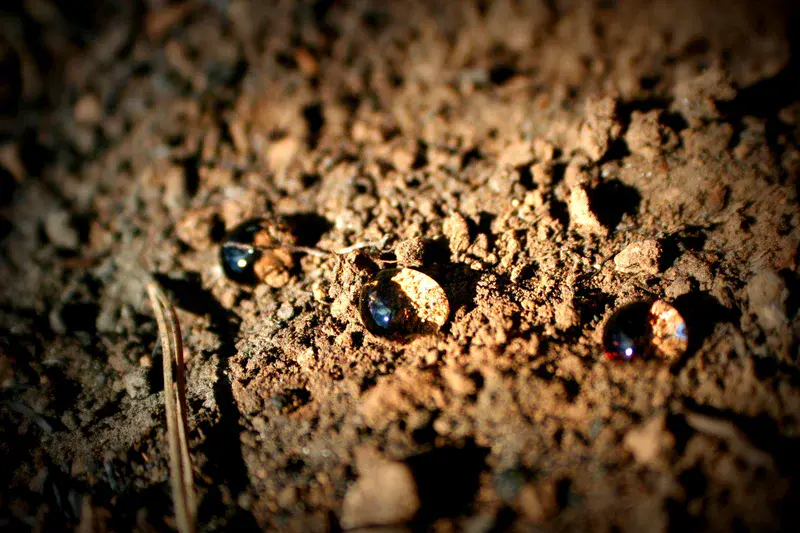
Soil water repellency
by Antonio Jordán, University of Seville, Sevilla, Spain
First, in English:
This photograph was taken a few days after a forest fire in a pine-forested area very close to Montellano (Sevilla, SW Spain), while planning some field experiments. In the image, several water drops are resting on a water-repellent soil layer without infiltrating.
The fire affected between 70 and 80 ha of a hardly accessible area, characterized by a pine dense forest, shallow soils and steep slopes. Originally an arson fire due to local struggles, fire quickly climbed the northern slope of the mountain, reached the top and moved down the southern slope in hours. The area is used by residents for recreative activities.
Water repellency is a property of soils which, until relatively recent times, has not received much attention. However, its geomorphological consequences are extremely important, since it limits water infiltration in soils, increasing runoff rates and enhancing soil erosion risk. Vegetation (tree species such as pines or eucalyptus, or shrubs such as heather), fungi and other soil midroorganisms are the main sources of hydrophobic organic substances in soils. Climate, soil texture and structure may also modulate the degree of hydrophobicity. Forest fires are a major cause of soil water repellency. During the combustion of litter and soil organic matter, organic substances from soil volatilize and escape as part of the smoke. However, another part can be displaced in depth and condense following a hot-to-cold gradient. These organic substances form hydrophobic coatings on the surface of soil particles and aggregates. So, when the soil reaches temperatures between 200 and 250 °C, water repellency can be increased or induced. If temperature peaks are higher, combustion and volatilization are more intense, and hydrophobic substances may be completely lost or destroyed.
Therefore, soil scientists use soil water repellency as an index of fire severity. A simple way to determine the degree of water repellency is to measure the time required for infiltration of water drops. As in this case, the development of a water-repellent soil layer together with the loss of vegetation cover that protects soil may trigger soil erosion processes in sensitive areas just to get the first storms of the wet season.
I shot the picture with a Canon EOS 350D, 0.6x/58 mm lens, f/10, exposure 1/400 s, ISO-400, and 55 mm focal length, equipped with UV filter.
Ahora, en español:
Esta fotografía fue tomada pocos días después de un incendio forestal en una zona de pinares muy cercana a Montellano (Sevilla, SO de España), mientras se planificaban algunos experimentos de campo. En la imagen, se pueden observar varias gotas de agua reposando sobre una capa de suelo repelente al agua, sin infiltrarse.
El incendio afectó entre 70 y 80 hectáreas de una zona de difícil acceso, caracterizada por un denso bosque de pinos, suelos poco profundos y pendientes pronunciadas. Originado por un incendio intencionado debido a conflictos locales, el fuego ascendió rápidamente por la ladera norte de la montaña, alcanzó la cima y descendió por la ladera sur en pocas horas. El área es utilizada por los residentes para actividades recreativas.
La repelencia al agua es una propiedad de los suelos que, hasta tiempos relativamente recientes, no había recibido mucha atención. Sin embargo, sus consecuencias geomorfológicas son extremadamente importantes, ya que limita la infiltración de agua en el suelo, incrementa las tasas de escorrentía y aumenta el riesgo de erosión del suelo. La vegetación (especies arbóreas como pinos o eucaliptos, o arbustos como el brezo), los hongos y otros microorganismos del suelo son las principales fuentes de sustancias orgánicas hidrofóbicas en los suelos. El clima, la textura y la estructura del suelo también pueden modular el grado de hidrofobicidad. Los incendios forestales son una causa importante de la repelencia al agua del suelo. Durante la combustión de la hojarasca y la materia orgánica del suelo, las sustancias orgánicas del suelo se volatilizan y escapan como parte del humo. Sin embargo, otra parte puede desplazarse en profundidad y condensarse siguiendo un gradiente de caliente a frío. Estas sustancias orgánicas forman recubrimientos hidrofóbicos en la superficie de las partículas y agregados del suelo. Así, cuando el suelo alcanza temperaturas entre 200 y 250 °C, la repelencia al agua puede incrementarse o inducirse. Si los picos de temperatura son mayores, la combustión y volatilización son más intensas, y las sustancias hidrofóbicas pueden perderse o destruirse por completo.
Por ello, los científicos del suelo utilizan la repelencia al agua como un índice de la severidad del fuego. Una forma sencilla de determinar el grado de repelencia al agua es medir el tiempo que tarda en infiltrarse una gota de agua. Como en este caso, el desarrollo de una capa de suelo repelente al agua, junto con la pérdida de la cobertura vegetal que protege el suelo, puede desencadenar procesos de erosión en áreas sensibles al llegar las primeras tormentas de la temporada húmeda.
Tomé la fotografía con una Canon EOS 350D, lente 0.6x/58 mm, f/10, exposición 1/400 s, ISO-400 y una longitud focal de 55 mm, equipada con un filtro UV.
Featured on GeoLog, the official blog of the European Geosciences Union
Categories
Location
- Europe (3883)
- Southern Europe (1683)
- Spain (811)
- Exact location (-5.5498 W, 37.0056 N)
Tags
- mediterranean soils (265)
- forest fire (31)
- fire (39)
- soil water repellency (12)
- wildfires (1)
- soil erosion (73)
Colours
Image properties
2496 × 1664 px;
image/jpeg; 900.3 KB
Camera:
Canon EOS 350D DIGITAL
Taken on 28
November
2012
Submitted on 27 January 2013
Licence
Creative Commons Attribution-NonCommercial-ShareAlike 3.0 Unported (CC BY-NC-SA 3.0)
Credit
Antonio Jordán (distributed via imaggeo.egu.eu)
Share
Appreciate
Report